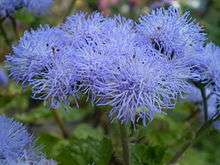Ageratum houstonianum
| Flossflower | |
|---|---|
.jpg) | |
| Scientific classification | |
| Kingdom: | Plantae |
| Clade: | Angiosperms |
| Clade: | Eudicots |
| Clade: | Asterids |
| Order: | Asterales |
| Family: | Asteraceae |
| Genus: | Ageratum |
| Species: | A. houstonianum |
| Binomial name | |
| Ageratum houstonianum | |
| Synonyms[1] | |
|
Synonymy
| |

Ageratum houstonianum (flossflower, bluemink, blueweed, pussy foot, Mexican paintbrush) is a cool-season annual plant often grown as bedding in gardens. The plant grows to 0.3–1 m high, with ovate to triangular leaves 2–7 cm long, and blue flowerheads (sometimes white, pink, or purple). The flower heads are borne in dense corymbs. The ray flowers are threadlike, leading to the common name.[2]
The plant is native to Central America and adjacent parts of Mexico, but has become an invasive weed in other areas.[3][4]
Ageratum has evolved a unique method of protecting itself from insects: it produces a methoprene-like compound which interferes with the normal function of the corpus allatum, the organ responsible for secreting juvenile hormone during insect growth and development. This chemical triggers the next molting cycle to prematurely develop adult structures, and can render most insects sterile if ingested in large enough quantities. [5]
Varieties
- A. houstonianum var. angustatum B.L. Rob.[6]
- A. houstonianum f. isochroum
- A. houstonianum f. luteum
- A. houstonianum var. muticescens
- A. houstonianum f. niveum
- A. houstonianum f. normale
- A. houstonianum var. typicum
- A. houstonianum f. versicolor
The cultivars 'Blue Danube'[7] and 'Blue Horizon'[8] have gained the Royal Horticultural Society's Award of Garden Merit.
Toxicity
Ageratum houstonianum is toxic to grazing animals, causing liver lesions.[9][10] It contains pyrrolizidine alkaloids.[11]
Weed risk
Ageratum houstonianum is prone to becoming a rampant environmental weed when grown outside of its natural range. It has become an invasive weed in the United States, Australia, Europe, Africa, China, Japan, New Zealand, and the Philippines.[12]
| Wikimedia Commons has media related to Ageratum houstonianum. |
References
- ↑ "Ageratum houstonianum Mill.". The Global Compositae Checklist (GCC) – via The Plant List.
- ↑ New South Wales Flora Online, Ageratum houstonianum
- ↑ Nesom, Guy L. (2006). "Ageratum houstonianum". In Flora of North America Editorial Committee. Flora of North America North of Mexico (FNA). 21. New York and Oxford – via eFloras.org, Missouri Botanical Garden, St. Louis, MO & Harvard University Herbaria, Cambridge, MA.
- ↑ Species profile
- ↑ I. Kiss; et al. (September 1988), "Biological activity of precocene analogues on Locusta migratoria", Cellular and Molecular Life Sciences, 44: 790–792, doi:10.1007/BF01959168
- ↑ JSTOR Plant Science
- ↑ RHS Plant Selector Ageratum houstonianum 'Blue Danube' AGM / RHS Gardening
- ↑ RHS Plant Selector Ageratum houstonianum 'Blue Horizon' AGM / RHS Gardening
- ↑ Acamovic, T., Stewart, C.S., Pennycott, T.W.,"Poisonous Plants and Related Toxins", 2004
- ↑ Noa, M., Sanchez, L.M., Durand, R., "Ageratum houstonianum toxicosis in Zebu cattle", Veterinary and human toxicology, 2004, vol.46, no4, pp.193-195.
- ↑ Wiedenfeld H, Andrade-Cetto A., "Pyrrolizidine alkaloids from Ageratum houstonianum Mill.", Phytochemistry, 2001 Aug, pp1269-71
- ↑ Global Compendium of Weeds, Ageratum houstonianum (Asteraceae)
- Bailey, L. H. (2005). Manual of Gardening (Second Edition). Project Gutenberg Literary Archive Foundation.